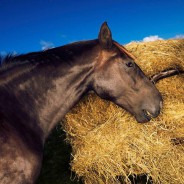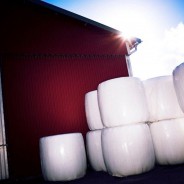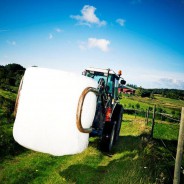The forage blog – all about forage for horses
Here AgrD Sara Muhonen blogs about feeding and forage for horses. If you have questions or suggestions on what we should discourse feel free to e-mail us via the contact page.
High DM concentration increase the risk of mould in haylage
Drier wrapped forages with DM concentrations between 50 and 80% are called haylage and at this high DM the risk of mould growth increase, partly due to a larger portion of air pits and higher risk for puncturing the plastic. Mould requires air to be able to grow. Moulds can form toxins, mycotoxins, which have negative impact on horses. Effects of mould damaged forage can appear as anything from reduced performance to neurological disorders. In this study the aim was to map the prevalence of mould in haylage and investigate correlations...
read moreForage vs. concentrate – effects on insulin response
This study examined the impact of the diet on insulin response at feeding and during a 12 fast in trotters in training. A diet consisting of only energy rich forage (haylage) was compared to a 50:50 forage:oats diet. The same haylage was used for the two diets and bots diets covered the maintenance requirements × 2 and were supplemented with minerals and salt. The haylage diet implied an intake of 151 g sugar and 12 g starch per 100 kg body weight (BW) and day. The haylage:oats diet implied an intake of 100 g sugar and 341 g starch per 100 kg...
read moreDifferences between starch and sugar
Starch are carbohydrates and they are in high concentrations in cereals, i.e. oats, barley, wheat and rye. In the small intestine starch is rapidly degraded to glucose and absorbed into the blood. When horses eat starch rich concentrates there is a risk that non digested starch reaches the hindgut causing the microflora to produce lactic acid which is a strong acid that can acidify the hindgut environment, read more about this here. Sugars are water-soluble carbohydrates and are found in for example grass and in grass the most common sugars...
read moreStarch rich concentrates impair hindgut environment
The horse is a monogastric herbivore, a hindgut fermenter, and is depending on the fibrolytic microflora in caecum and colon to ferment fibre to short-chain fatty acids. Therefore it is important that the environment in caecum and colon, the hindgut, is right and this can be investigated by measuring the pH value. pH is a measure of acidity and the lower the pH the more acid is the environment. When the microflora ferment fibre and produce short-chain fatty acids like acetic acid, propionic acid and butyric acid pH decreases moderately. Acids...
read moreNumber of layers of plastic impact bale gas tightness
Number of layers of plastic film on the bale has an impact on the bale’s gas tightness. In this study the bale gas tightness, density, surface damages, total nutrient losses and losses caused by surface mould growth was investigated when wrapping bales with 6 or 8 layers of Horsewrap and regular standard bale wrap. 16 bales with each 6 and 8 layers of stretch film were wrapped with Horsewrap and standard bale wrap, in total 64 bales. The crop was 2 cocksfoot leys from the second cut. The two stretch films were 25 µm thick, 750 mm wide and pre...
read moreWiden the window for harvest with several days
Different plants have different time points for ear emergence and can therefore be early or late. Even within some grass species there are large differences in earliness between varieties. Different species and varieties have different ability to maintain the energy value at ear emergence. Different time points for ear emergence implies different time points for suitable harvest date. The window for harvest can be prolonged with a few days by choosing a mixture of species and varieties that together gives a more slowly decrease in energy...
read moreHarvest date can effect haylage hygienic quality
Wrapped forages for horses are commonly harvested in a relatively late botanical growth stage. Plant maturity influences not only the nutritional content but also the composition of the microflora living on the crop which can influence the conservation of the feed. This study that was performed in Sweden has examined how late harvest date affects the hygienic quality of the forage. The microbial and chemical composition in haylage during conservation and storage was compared between three first harvests from the same lay (mainly timothy and...
read moreGood advice before harvest
To get a good hygienic quality of forage it is important to be thorough at harvest, handling and storage. Here are some good advice for harvest, handling and storage of wrapped forage: • When raking the crop into swaths it is important to try to get as even and good shape of the swath as possible. A badly shaped swath gives an uneven density in the bales, which affects the function of the baler’s side tip but also the impact of the bale handler and storage. • The bale wrapper has to be set right in order for the plastic film to be applied...
read moreWide-spreading compared to swathing
When forage is conserved as wrapped bales it is recommended to pre-wilt in the field. Usually the mower places the crop in swaths in the field. However, the crop dries faster and in a more controlled way if the mower places the crop wide-spread instead. In this study the two wilting techniques swathing and wide-spreading and the hygienic quality of the feed when these techniques were used were compared. After 25 hours of wilting in the field the crop was baled in round bales, then the DM concentration after wide-spreading of the crop was 40%...
read moreForage-only diets have positive effects on performance
A Swedish study has examined the impacts on body weight and exercise response in trotters in training when fed a forage-only diet compared to a 50:50 forage:concentrate diet. The forage-only diet consisted of early harvested energy rich haylage and the forage:concentrate diet consisted of late harvested haylage from the same ley. The concentrate consisted of mainly oats and soybean meal and both diets were supplemented with minerals and salt. The two diets, forage-only and forage:concentrate, provided the same daily energy and protein intake....
read more









